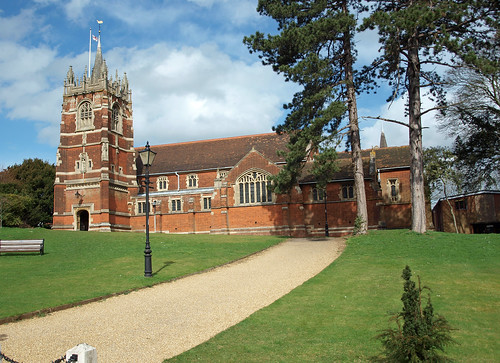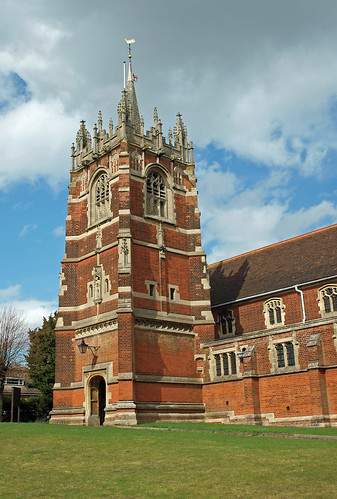St John is Victorian new build being consecrated in 1889. Once the village moved westwards from Stansted Hall and left St Mary remote from the heart of the village a new church was required hence St John's existence. It is all that you'd expect of a Victorian church.
ST JOHN THE EVANGELIST. 1889 by Caroe, an early work of his, but already with the touches of wilfulness which characterize his style. The tower a little later; 1895, and consequently more original. The interior in fact, with exposed brick, is still quite conventional. Nave and S aisle. The only distinguishing detail is the canted W balcony. The tower, also very red, as is the whole church, treats the Perp of the church freely. Tower top with gargoyles, pinnacles, stepped battlements, and a lantern-shaped upper ending of the stair turret.
ST JOHN THE EVANGELIST. 1889 by Caroe, an early work of his, but already with the touches of wilfulness which characterize his style. The tower a little later; 1895, and consequently more original. The interior in fact, with exposed brick, is still quite conventional. Nave and S aisle. The only distinguishing detail is the canted W balcony. The tower, also very red, as is the whole church, treats the Perp of the church freely. Tower top with gargoyles, pinnacles, stepped battlements, and a lantern-shaped upper ending of the stair turret.
STANSTED MOUNTFITCHET. Its houses look down on a Roman road, but its name comes from the Norman family of Mountfitchet, whose castle was destroyed in the year of Magna Carta. There are traces of its earthworks and some rubble foundations. There are Tudor houses here with their imposing timbers, one in Church Road with brackets carved with foliage, and others of the 17th and 18th centuries. A fine tower windmill stands in the background.
The church is a little way off in the 200 acres of Stansted Hall, and has three archways through which men were walking in Norman days, a chancel arch carved with small heads and two doorways with tympanums, all with Norman decoration. The tower is 17th century, but the chancel was refashioned by the 13th century men, and has graceful shafts and a handsome wall arcade. It opens to a chapel by two arches, one of the l3th century, with rich foliage on its capitals, and one of the 14th. Five big linenfold panels are left from a Tudor screen, and from the 17th century are two carved chairs, an attractive cover for the 700-year—old font, and a curious panel carved with the thirty pieces of silver, the Crown of thorns, a kneeling cherub, and instruments of the Passion. There are two fine candlesticks from Italy; a reredos with the Resurrection, the Tree of Life, and a phoenix; and a window of Faith and Hope in memory of a father who died in 1915 and his son killed in France two years later.
The oldest monument is the worn figure of a cross-legged knight in armour, said to be Roger de Lancaster from the beginning of the 14th century. He wears a surcoat, and has his feet on a grinning lion. Far more imposing is the great marble monument, 20 feet high, of Sir Thomas Middleton who died in 1631. He is wearing a fur cloak over his armour, and the collar he wore as Lord Mayor of London; there are angels by the inscription, and seven shields of arms. His wife lies on an altar tomb panelled and carved with elaborate heraldry. She is a coloured figure wearing a cloak, a lace collar, and a tall hat, and her sad little story is that she was killed by a stag in the park.
Simon K:
The church is a grand sight on the hillside, the 1880s early work of Water Caroe (who did Eversden) so in full fantastic flight. The red brick tower is engulfed in statues and tracery.
As big as the exterior looks, the interior is warm and intimate, the woodwork of the chancel instantly reminiscent of Elveden.
Thankfully, the nave was full of modern chairs (Caroes work hasn't been replaced, the parish ran out of money in the 1890s) and this is a good offsetting for the low arches and a lovely curved balcony.
Flickr.


No comments:
Post a Comment